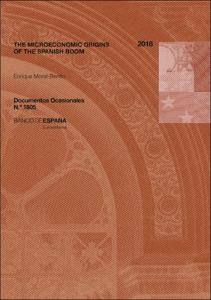The microeconomic origins of the Spanish boom
Autor
Fecha de publicación
10-may-2018
Descripción física
26 p. : gráficos
Resumen
El patrón de crecimiento de la economía española durante el período 1995-2007 se caracterizó por el notable aumento del empleo y de la inversión, así como por la ausencia de ganancias en productividad. Estos desarrollos macroeconómicos se combinaron con un aumento del crédito bancario, que, a su vez, se vio favorecido por incrementos sin precedentes en los precios del mercado inmobiliario. Este artículo resume una línea de investigación que explora la conexión entre estos desarrollos de acuerdo con datos microeconómicos sobre empresas y bancos españoles. La evidencia disponible sugiere que la abundante disponibilidad de crédito, parcialmente inducida por la burbuja inmobiliaria, y su propagación a través de la estructura productiva española explican una parte considerable de la acumulación masiva de empleo y capital. Además, el deterioro en la asignación de recursos entre empresas dentro de cada sector se revela como el principal responsable de la caída en la productividad agregada. La asignación del crédito entre las empresas, la relajación de los estándares crediticios de los bancos y la baja productividad de las empresas españolas pueden explicar, al menos parcialmente, este fenómeno
The Spanish growth experience over the 1995-2007 period was characterized by the remarkable surge in employment and investment as well as the dismal evolution of productivity. These macroeconomic fluctuations were coupled with an unprecedented credit boom fueled by a housing bubble. This article reviews a line of research that investigates the connection between these developments using micro-level data on Spanish fi rms and banks. The evidence suggests that the abundant availability of credit, partially induced by the real estate bubble, and its propagation through the Spanish production network explain a sizable part of the massive accumulation of labor and capital. Also, the deterioration in the allocation of resources across firms is the main responsible of the fall in aggregate productivity. The allocation of credit across firms and municipalities, the softening of banks lending standards, and the low productivity of Spanish firms can partly explain this deterioration
The Spanish growth experience over the 1995-2007 period was characterized by the remarkable surge in employment and investment as well as the dismal evolution of productivity. These macroeconomic fluctuations were coupled with an unprecedented credit boom fueled by a housing bubble. This article reviews a line of research that investigates the connection between these developments using micro-level data on Spanish fi rms and banks. The evidence suggests that the abundant availability of credit, partially induced by the real estate bubble, and its propagation through the Spanish production network explain a sizable part of the massive accumulation of labor and capital. Also, the deterioration in the allocation of resources across firms is the main responsible of the fall in aggregate productivity. The allocation of credit across firms and municipalities, the softening of banks lending standards, and the low productivity of Spanish firms can partly explain this deterioration
Publicado en
Documentos Ocasionales / Banco de España, 1805
Materias
Datos de empresa; PTF; Asignación de recursos; Relaciones input-output; Spain; Firm level data; TFP; Misallocation; Input-output linkages; Producción y mercado; Evolución y desarrollo económicos; Créditos; Financiación de la empresa; Estructura y funcionamiento de la empresa; España
Aparece en las colecciones:












